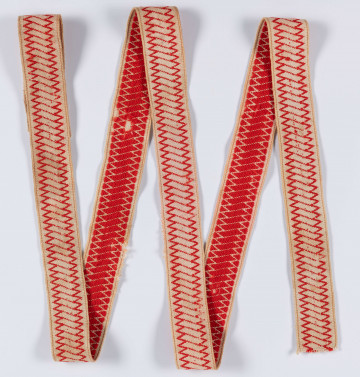
Doll in the Biłgoraj man's costume
1901 — 1920
National Museum in Lublin
Part of the collection: Folk craft of the Lublin Region (19th/20th c.)
The history of the toy doll begins in the 16th century. It was then that the production of dolls on request began. The newly discovered plastic material mâché paper created many possibilities. The head, arms and legs were usually made from it, the torso was a rag doll body. Such a doll was a luxury product: it had a hairstyle made of human hair or horse hair, a painted face, and clothes made of expensive fabrics. In the 17th century in Europe no less popular were toys made of wax, which when mixed with pigment and animal fat gave a colour similar to human skin. Thanks to its plasticity it was perfect for modelling the facial features of dolls. In the 19th century porcelain reigned supreme at European courts. Dolls still had a rag doll body, but their head was made of porcelain or bisque, called unglazed porcelain. This ceramic mass, by being baked at a lower temperature, was less durable, but with its matte surface it realistically reflected the texture of the skin. Biscuit dolls had carefully painted features, eyes made of glass and a wig made of human hair or, for example, mohair. They were dressed in very rich costumes, as their purpose was to draw attention to fashion. They could dress up and sew their own clothes, using special magazines with patterns and instructions. Adorned according to the prevailing fashion trend of the season in clothing and hairstyle, often identical with the appearance of their owners, they became their miniatures. At that time, they were not only toys, but also a decorative element and an object for collectors.
Such dolls were made of delicate material; thus, their price was quite high. Although they were ordered for children, the way they played with them was very different from today's standards. They tended to accompany girls, for example, when eating meals or reading books, rather than playing with them. That's why a biscuit doll dressed in a typical bride's Biłgoraj cloth costume, indicated by a headdress - a garland with colourful ribbons - is a mystery. How did she appear in folk culture, where one would more likely expect rag dolls - cuddly dolls?
Author / creator
Dimensions
cały obiekt: height: 36 cm
Object type
toy
Technique
own
Material
porcelain, fabric, leather (processed), horsehair
Creation time / dating
Creation / finding place
Owner
The National Museum in Lublin
Identification number
Location / status

1901 — 1920
National Museum in Lublin

1890 — 1910
National Museum in Lublin

1901 — 1950
National Museum in Lublin
DISCOVER this TOPIC
Museum of King Jan III's Palace at Wilanów
DISCOVER this PATH
Educational path